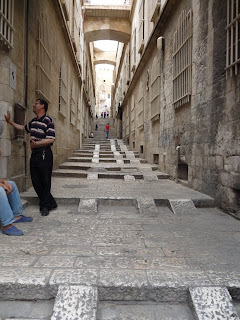
After leaving the Pools of Bethesda we travelled a few yards along the Via Dolorosa. We saw the 'Ecce Homo' arch (behold the man), which tradition states was where Pilate displayed Jesus to the crowd. Archeology suggests the arch was built slightly later.

Attached to the arch is the Ecce Homo convent.


The convent is a pilgrim house, where visitors can stay or visit, and it is next to the Ecce Homo church.


The roof of the convent is a huge verandah which has panoramic views across to the Dome of the Rock, and other sights of Jerusalem.

We ate lunch in the roof-level dining room. This is a good place to see over Jerusalem and start to get an idea of the very short distances between many of the points of interest. Everywhere there is a church there is also a minaret, which is a reminder of the troubled history of this city.

This is the view back towards the Lion Gate along the Via Dolorosa.

The convent is built over the Lithostrotos, an ancient Roman pavement at the level that the road would have been during Jesus' time.
Traditionally this is celebrated as the original pavement on which Jesus walked, but again the archeological evidence disputes this. The nuns are careful to point out that they do not claim this as true; simply that this is where they remember that event.


I found it a good indication of the type of environment, and seeing the striations on the re-cycled paving stones, and the Roman games of chance carved into the stones (just as we also saw in the souk and elsewhere) helped me to imagine what it might have been like then. The area is set out as a chapel, and there are several points where the pilgrim can just sit quietly and ponder. This rather beautiful mosaic is a visual reminder of Christ's final journey.



The Lithostrotos is actually the cover to a huge underground water cistern called the Strouthion Pool (we saw the other side of it when we went to the Western Wall tunnels).
The window in the top of the photo on the left is at ground level - as you can see from the right-hand picture, there is a steep street along the side of the wall, and the window is on the bottom right at ground level. This puts the height of the Lithostrotos in better perspective.


We continued down the steps, below the level of the Roman pavement to investigate the water systems below ground. It was very dark and damp and we didn't have a lot of time to read all the notices explaining the layout. But much of it became clear the following day when we visited the Western Wall Tunnels, and were told this story.
In the 19th Century a British archeologist who was excavating the Hasmonean water system from the Western Wall side came upon a large underground pool. He wasn't entirely sure where he was, in relation to the buildings above ground, and set out in the dark, on a makeshift raft to find the other side of the huge pool. He was then fascinated to discover a door in the end wall. Being very British, he knocked on the door, which was opened by an extremely surprised nun. The nuns had thought until that point that they drew water from a closed pool. While they were apparently polite to him, their reaction to discovering a rather dusty floating archeologist was to build a solid wall that now separates the Strouthion Pool and isolates the convent.
Although this story is not mentioned on their website, you can see the wall in one of the photographs.




No comments:
Post a Comment